Optimal Timing and Techniques for Lawn Aeration


Intro
Lawn aeration is a crucial practice for maintaining a healthy and vibrant lawn. It involves perforating the soil with holes to allow air, water, and nutrients to penetrate deep into the root zone. This process enhances soil structure and reduces compaction, which is vital for optimal grass growth. Understanding the timing and techniques involved in lawn aeration can significantly impact the overall health and appearance of your lawn.
Topic Overview
Definition and Importance
Lawn aeration is the mechanical process that creates small holes in the soil. This allows essential elements like oxygen, water, and nutrients to reach the grassroots more effectively. The significance of aeration cannot be overstated; it helps alleviate soil compaction, improve drainage, and foster a healthier lawn. Regular aeration can mitigate issues caused by heavy foot traffic and promote a more robust root system.
Brief History and Evolution
Historically, various methods have been employed to aerate soil, from simple manual instruments to more advanced machinery. The evolution of aeration techniques has been driven by the growing awareness of lawn care's importance among homeowners and agricultural professionals alike. Early tools were labor-intensive and limited in effectiveness, while today’s innovations include powered aerators that allow for efficient, extensive coverage of larger areas.
Key Techniques and Innovations
Sustainable Farming Practices
Adopting sustainable practices in lawn aeration is key for environmental health. Sustainable aeration focuses on using organic materials and methods to minimize ecological impact. This may include using natural fertilizers post-aeration to enhance soil nutrients without harmful chemicals. Also, selecting the appropriate seasons for aeration helps avoid stress on the grass and promotes natural recovery.
Advanced Agronomic Technologies
Technological advancements in agronomy have transformed lawn aeration. Innovations such as GPS-guided aerators improve precision in application, ensuring that the entire area is aerated effectively. Soil monitoring technologies can assess compaction levels and moisture, providing valuable data to help determine the best aeration timing.
Practical Applications
Step-by-Step Guides
- Determine the Timing: Aerate during the growing season for your grass type. For cool-season grasses, early spring or fall is ideal. For warm-season grasses, late spring or summer works best.
- Prepare the Lawn: Mow the grass shorter than usual and water the lawn a day or two before aeration to soften the soil.
- Select the Right Equipment: Choose between core aerators, which remove small plugs of soil, and spike aerators, which simply poke holes into the ground.
- Aerate the Lawn: Follow the manufacturer’s guidelines for your aerator. Ensure even coverage.
- Post-Aeration Care: Leave the soil cores on the surface to break down naturally, and consider applying an organic fertilizer to enhance nutrient availability.
Case Studies or Real-World Examples
In many urban areas, lawns subjected to heavy use, such as parks or sports fields, demonstrate the benefits of regular aeration. Parks in San Francisco have shown that after implementing a biannual aeration program, the grass not only appears greener but also withstands seasonal drought more effectively. Such case studies underscore the practical benefits and long-term value of aerating to ensure a healthy green space.
"Aeration improves the health of the soil, which is fundamental for sustainable lawn care practices." - Agronomy Research Journal
By understanding the best practices associated with lawn aeration, both amateurs and professionals can ensure their lawns remain lush and healthy throughout the year.
Understanding Lawn Aeration
Lawn aeration is a crucial process that enhances the health of your lawn. Understanding it sets the foundation for maintaining a lush and vibrant green space. It enables both novice and experienced caretakers to appreciate why and how to aerate properly.
Definition of Lawn Aeration
Lawn aeration is the process of perforating the soil with holes to allow air, water, and nutrients to penetrate deep into the roots. This process is essential for relieving compaction, improving soil structure, and fostering healthier grass. Aeration generally involves removing small plugs of soil from the lawn. These plugs are left on the surface to decompose, returning essential nutrients back to the soil.
Purpose of Aeration
The primary purpose of lawn aeration is to alleviate soil compaction. Compacted soils restrict root growth, limit water infiltration, and inhibit nutrient absorption. Additionally, aeration encourages the development of a robust root system, which is vital for grass health. By enhancing air circulation within the soil, you also create a better environment for beneficial microorganisms that contribute to soil fertility.
"Aeration not only benefits the grass; it enhances the overall ecosystem of your lawn, allowing for improved sustainability."
Through effective aeration, turf managers and lawn enthusiasts alike can optimize their lawn appearance and health. Ultimately, understanding lawn aeration is fundamental to achieving a beautiful and thriving outdoor space.
Benefits of Lawn Aeration
Lawn aeration plays a vital role in maintaining a healthy and vibrant lawn. It involves perforating the soil with holes to allow for the exchange of air, water, and nutrients. By understanding the benefits of this practice, gardeners can greatly improve the overall condition of their lawns. Aeration helps address specific issues such as excess soil compaction, inadequate water penetration, uneven nutrient distribution, and weaker root systems. Focusing on these elements leads to improved lawn aesthetics and healthier grass growth.
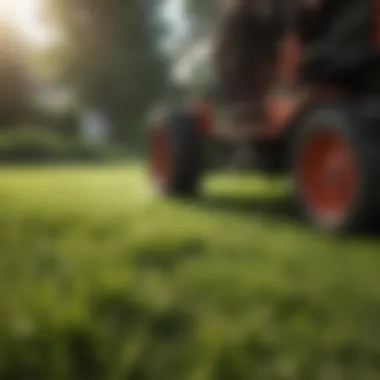
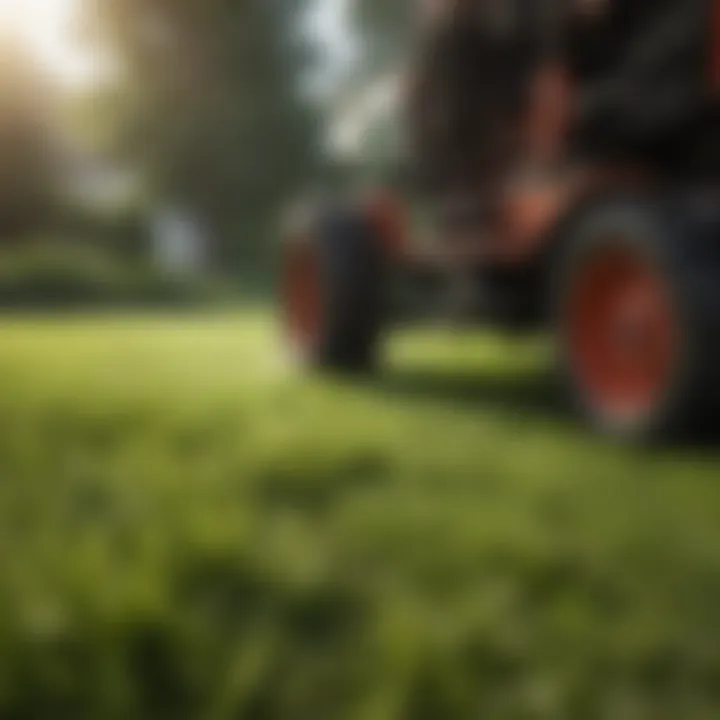
Soil Compaction Relief
Soil compaction is a common problem in lawn care. Over time, natural forces, foot traffic, and mechanical maintenance compress the soil particles, reducing the pore spaces in soil. This condition leads to limited air circulation, hindering root growth. Aeration alleviates this issue by creating holes in the soil, thereby reducing compaction and improving air exchange. When the soil is less compact, grass roots can expand and establish themselves more effectively. This relieves pressure on the roots and promotes a balanced ecosystem in the soil, allowing for vital biological activity.
Improved Water Penetration
Aerated lawns experience better water drainage and infiltration. In compacted soil, water tends to run off rather than soak in. This results in dry patches and uneven moisture distribution. Aeration allows water to penetrate deeper into the ground, reaching the roots where it is needed most. As moisture is more evenly distributed, grass can absorb necessary water efficiently. This enhances the lawn's resilience against drought and helps to maintain its green appearance throughout the growing season.
Enhanced Nutrient Distribution
Nutrients are essential for healthy grass growth. Compacted soil restricts the movement of nutrients, limiting their availability to plants. By aerating the lawn, gardeners can improve nutrient distribution. Aeration allows fertilizers and organic matter to reach deeper into the soil where they can be most effective. When nutrients are more accessible, grass can utilize them for growth and development, resulting in lusher and greener lawns. This practice is particularly beneficial when combined with top dressing methods, further enhancing nutrient availability.
Root Development
Deep-root growth is critical for a robust lawn. Aeration promotes healthier root systems by providing them with the necessary space to expand. When soil has sufficient oxygen and nutrients, roots can grow deeper and establish a strong foundation. This not only improves the lawn's aesthetics but also enhances its resilience to environmental stressors like heat, drought, and pests. Strong roots also contribute to overall plant health and longevity. By prioritizing aeration, land caretakers are investing in the long-term success of their lawns.
Factors Influencing Aeration Timing
Understanding the factors that influence the timing of lawn aeration is crucial for maintaining a healthy lawn. Various elements play a significant role in determining the best time to aerate, such as grass type, soil condition, and seasonal changes. Recognizing these factors allows lawn caretakers to plan effectively, ensuring the best outcomes from aeration efforts. The right timing can lead to enhanced penetration of air, water, and nutrients into the soil, ultimately benefiting the entire lawn ecosystem.
Grass Type
Cool-Season Grasses
Cool-season grasses, such as Kentucky bluegrass and fescue, thrive in the northern regions where temperatures are cooler. These grasses are particularly beneficial in temperate climates because they grow vigorously during the spring and fall, making them ideal candidates for lawn aeration during these seasons. A key characteristic of cool-season grasses is their ability to recover quickly from stressful conditions.
Aerating cool-season grasses tends to promote root development and soil health, leading to denser turf. These grasses also have unique features that allow them to survive harsh winter conditions, but poor soil aeration can weaken them. Therefore, timing aeration in the early spring or fall is crucial for ensuring these grasses maintain their vigor.
Warm-Season Grasses
Conversely, warm-season grasses, including Bermuda and zoysia, prosper in the southern regions where temperatures are higher. These grasses are known for their robust growth during warm months, thus making summer the optimal time for aeration. A distinctive characteristic of warm-season grasses is their drought tolerance, which can be advantageous in maintaining a lush lawn even in dryer climates.
However, timing is still important, as aeration performed during the wrong season could lead to dormant grass that doesn’t recover well. This can result in patches and thin areas in the lawn. Thus, understanding when to aerate based on the type of grass can maximize lawn health and maintenance.
Soil Conditions
Soil Moisture Levels
Soil moisture plays a pivotal role in aeration effectiveness. Proper moisture levels allow aeration devices to penetrate the ground more easily, making it vital to assess soil moisture before proceeding. If the soil is too dry, it can become compacted, making aeration less effective. Adequate moisture can lead to better air circulation and nutrient absorption, ultimately promoting healthy grass growth.
It's advised to check the moisture levels by performing a simple soil test, which can indicate whether the ground is suitable for aeration. Well-hydrated soil provides the best conditions for aeration, balancing the delicate ecosystem of nutrients beneath the surface.
Soil Texture
Soil texture can greatly influence the aeration process as well. Sandy soils tend to drain quickly, while clay soils retain water and can become compacted more easily. The texture affects how water and air move through the soil, impacting root accessibility.
For example, clay soil can benefit greatly from aeration because it is typically denser and requires physical perforation to improve water penetration. However, aerating is less effective for sandy soils since water drains so quickly that it fails to build up in the soil profile. Understanding the texture of your soil will help in planning the ideal timing for aeration.
Time of Year
Spring Aeration
Spring is traditionally regarded as an excellent time for aeration, especially for cool-season grasses. As temperatures rise and conditions become more favorable, aeration can promote robust growth and rejuvenation in the lawn. Spring aeration encourages deeper roots and overall healthier grass as it prepares the lawn for the growing season ahead.
However, it is essential to consider the local climate. Expanding roots in spring can also strengthen the lawn against summer heat. The timing within spring can vary, indicating careful observation is necessary to identify when your grass begins to actively grow.
Fall Aeration
Fall aeration mirrors the principles of spring aeration but focuses more on the preparation for winter. By aerating in the fall, you help cool-season grasses thrive as they prepare to face colder temperatures and potential stressors. Fall aeration offers the advantage of revitalizing root systems just before dormancy. This can set the lawn up for a strong comeback in the spring.
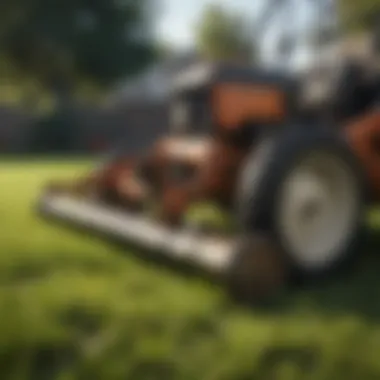
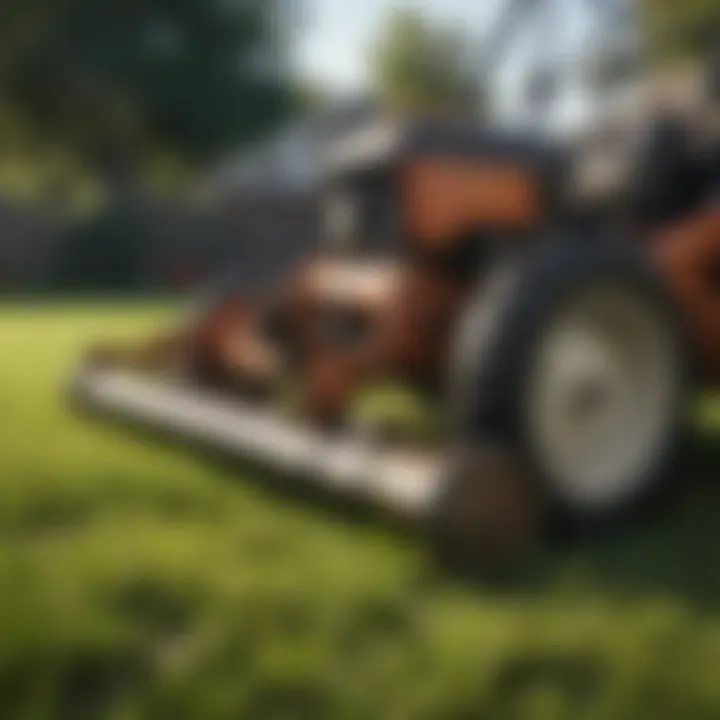
In many cases, fall aeration alleviates soil compaction that can build up during the summer months while assisting in nutrient absorption. Knowing when to aerate during the fall can significantly improve a lawn's overall resilience and appear.
Proper timing of aeration is essential for optimal lawn health and aesthetics, making factors like grass type, soil conditions, and seasonal variations all integral to the process.
Signs Your Lawn Needs Aeration
Determining when to aerate your lawn is essential for maintaining its health and appearance. Recognizing the signs that suggest your lawn needs aeration can significantly enhance its growth potential. Effective aeration alleviates compaction and fosters optimal growth conditions. In this section, we will explore three major indicators that imply your lawn would benefit from aeration, ensuring that you are better prepared to take action.
Visible Soil Compaction
Soil compaction is a primary sign that your lawn may require aeration. When you observe areas of your lawn that appear hard and dense, it is often due to soil particles being tightly packed together. This compaction interferes with essential processes, such as water infiltration, root development, and nutrient absorption. To identify compacted soil, consider walking on your lawn. If you notice that areas feel firm underfoot or water seems to pool rather than soak in, these are clear indicators of compaction.
Ignoring visible compaction can lead to stunted grass growth, increasing vulnerability to pests and diseases. Addressing this issue through aeration can relieve pressure and restore essential airflow and moisture to the root system.
Poor Drainage
Poor drainage is another significant indicator that your lawn requires aeration. If your lawn has areas that retain water for prolonged periods after a rainfall or watering, it suggests that the soil structure is insufficiently porous. Compact soil restricts water from percolating deep into the ground, leading to potential erosion or waterlogging.
Significant water runoff can also lead to nutrient loss, as beneficial elements may wash away. A lawn exhibiting poor drainage not only appears unhealthy, but it also poses challenges for any other maintenance efforts. Regular aeration can effectively combat these issues by breaking up compacted zones, allowing water to flow freely and nourish the grass.
Thinning Grass
Observing thinning grass across your lawn is a telltale sign that aeration is necessary. If patches of grass are sparse or non-existent, it may be due to a lack of adequate root space or air circulation. Thick, healthy grass relies on a robust root system. When roots are confined due to compaction, competition for nutrients intensifies, resulting in poor growth.
Aerating your lawn allows for space to be made, improving access to air, water, and nutrients. In conjunction with consistent lawn care practices, aeration can help rejuvenate thinning areas and promote a lush, vibrant appearance.
In summary, monitoring these signs will enable lawn caretakers to proactively manage their aeration needs. Look out for visible soil compaction, poor drainage, and thinning grass. Addressing these issues through aeration will enhance your lawn's resilience, promote healthy growth, and make your lawn a source of pride.
Techniques for Aerating Lawns
The choice of aeration technique can greatly impact the health of your lawn. Selecting the right method not only addresses existing soil issues but also enhances the overall resilience of the grass. The two primary techniques for aerating lawns are core aeration and spike aeration. Each has its own advantages, and understanding them will help you make an informed decision when the time comes to aerate.
Core Aeration
Core aeration is a method that removes small plugs of soil and thatch from the lawn. This technique creates space in the soil, allowing oxygen, water, and nutrients to penetrate deeper down. The benefits of core aeration are significant:
- Reduced Soil Compaction: Removing these soil plugs alleviates compaction, a common issue in most lawns.
- Enhanced Root Growth: With better access to nutrients and moisture, roots can grow deeper, improving the overall health of the grass.
- Thatch Control: It helps in managing thatch levels, which can suffocate the lawn when too thick.
It is advisable to consider soil moisture levels before performing core aeration. If the soil is too dry, the plugs may not be easily removed. Conversely, overly wet soil can lead to a messy process, making this method less effective. Regularly scheduling core aeration, typically once or twice a year depending on lawn traffic and conditions, can keep the lawn in optimal shape.
Spike Aeration
Spike aeration differs by not removing any soil but rather punctures the soil with spikes or tines. This creates holes that allow air and nutrients to reach the roots. Some benefits include:
- Quick Process: Spike aeration is generally faster than core aeration since it does not involve soil removal.
- Ideal for Thinner Lawns: For lawns with less severe compaction, spike aeration can provide sufficient relief by creating necessary openings.
- Low Disruption: This method is less disruptive to the surface than core aeration, making it a suitable choice for areas with heavy foot traffic under certain circumstances.
However, spike aeration may not be effective on heavily compacted soils. The method simply makes holes without relieving compaction, so its effectiveness can be limited.
Effective lawn care involves understanding which aeration technique is best for your specific lawn conditions.
In summary, choosing between core aeration and spike aeration depends on your lawn’s unique conditions and needs. Each method serves its purpose, and integrating them based on the lawn's response is key to maintaining a healthy and resilient garden.
Preparing for Aeration
Preparing for lawn aeration is a vital step that significantly impacts the effectiveness of the process. Proper preparation ensures that aeration yields the maximum benefits for your lawn. The two major components of preparation include mowing the lawn and watering before aeration. Each of these aspects plays a crucial role in enhancing the efficiency of aeration and improving the overall health of the turf.
Mowing the Lawn
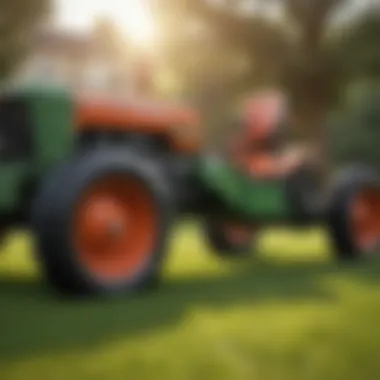

Mowing the lawn before aeration is a step that should not be overlooked. Cutting the grass to a shorter length reduces the amount of leaf material that may obstruct the aerator from penetrating the soil effectively. Maintaining a height of about 2 to 3 inches is usually recommended. This shorter grass offers easier access to the soil, which is essential for the aeration plugs to be effective.
When the grass is shorter, it allows the aerator to reach down without dealing with too much weight from the grass blades themselves. If the turf is too long, it can result in uneven aeration coverage, which defeats the purpose of the process. Moreover, mowing also helps remove debris and dead grass that could interfere with the aeration process.
Watering Before Aeration
The moisture level of the soil plays an important role when it comes to aeration. Watering the lawn a day or two prior to aeration can improve the soil's structure and make it easier to penetrate. The goal is to achieve evenly moist soil, which enhances the aerator’s ability to extract soil cores with minimal resistance.
Just enough water should be applied to avoid over-saturation, which could lead to compaction issues. A garden hose can be used to apply water evenly over the area, or a rain gauge can help to measure the appropriate amount of moisture. This step assists the aeration process by ensuring that the soil is workable but not muddy.
Effective preparation creates better conditions for aeration, ultimately enhancing the overall health and resilience of the lawn.
By taking the time to mow and water properly before aeration, care takers can ensure that the grass receives the full benefits of increased nutrient absorption, enhanced water penetration, and improved root growth. Each of these elements contributes to a lush, vibrant lawn, thereby making preparation a critical phase in the aeration process.
Post-Aeration Care
Post-aeration care is vital to ensure the long-term benefits of aeration are realized. After the lawn has been aerated, important procedures need to be followed to maximize the advantages. Proper care focuses on nurturing the turf to recover and establish optimal growing conditions. This stage can significantly influence the effectiveness of the aeration process, possibly determining the health and sustainability of your lawn.
One of the priority tasks after aeration is to ensure the soil is adequately nourished. Top dressing with soil is a key step in this process. During aeration, soil cores are removed, and spaces are created which allow air, water, and nutrients to penetrate deeper.
Top Dressing with Soil
Top dressing involves spreading a thin layer of high-quality soil or compost over the lawn to fill the holes left by core aeration. This practice improves surface soil quality, enhances moisture retention, and facilitates weed suppression. The chosen material should be lightweight, rich in nutrients, and free from weed seeds to prevent future issues.
Applying a light layer, typically around one-quarter inch thick, helps in maintaining good drainage and prevents compacting the newly aerated soil. It also allows new grass seeds to establish better contact with the soil. This step is particularly beneficial for lawns that suffer from compact or poor soil conditions.
Benefits of top dressing include:
- Enhanced soil structure
- Improved organic matter content
- Boosted microbial activity
Overseeding Strategies
Following the top dressing, overseeding is an important strategy to promote a lush, green lawn. This involves spreading grass seed over the existing turf to rejuvenate thinning areas and fill in bare spots. Ideally, overseeding should align with the natural growth cycles of the grass type in your lawn.
When overseeding, choose a grass variety that complements your existing species. It is crucial to select seeds with similar growth habits to prevent competition between different grasses. Additionally, ensuring the seeds are of high quality will lead to better germination and growth rates.
For optimal results, it’s advisable to aerate before overseeding to create small pockets for the seeds to nestle in, enhancing the chances of germination. Reseeding can be done immediately after aeration, taking into account the following considerations:
- Timing: Match overseeding with the appropriate season for your grass type.
- Seed-to-soil contact: Reseed on moist soil to maximize seed germination.
- Watering: Maintain consistent moisture post-overseeding to encourage growth; this usually means watering daily until seedlings establish.
Effective post-aeration care, including top dressing and overseeding, is fundamental. These steps ensure your lawn can effectively recover and thrive, taking full advantage of the aeration benefits.
Common Mistakes in Aeration
Understanding common mistakes in aeration is crucial for achieving a healthy lawn. Many people may not realize that improper aeration can lead to more harm than good. Education about these mistakes can guide lawn caretakers to make informed decisions that promote optimal results. It ensures that the already delicate balance between soil health and plant growth is not disturbed. Identifying frequent misjudgments can save time, money, and resources in the long run.
Aerating Too Frequently
Aerating too frequently is a mistake some gardeners make, thinking that more aeration equals better results. This notion is flawed. Excessive aeration can disturb the soil structure and create unnecessary stress for the grass. Ideally, lawns benefit from aeration once or twice a year, depending on local conditions and lawn type.
Over-aeration can lead to soil disruption. When soil is constantly being aerated, it loses essential microorganisms and can suffer from nutrient imbalance. Thus, understanding the balance is key. Observing the condition of your lawn can provide guidance on whether it's time for aeration or not. Signs that indicate the need for aeration include poor drainage and visible light brown patches.
Ignoring Soil Conditions
Ignoring soil conditions before aerating is another common pitfall. Each lawn is unique, with variations based on soil type, moisture levels, and compaction. For optimal aeration results, one must assess these conditions. Aerating dry or overly saturated soil can lead to further issues rather than improvements.
Before aerating, it is important to check the moisture levels. Ideally, soil should be damp but not waterlogged. Additionally, the texture should be noted. Sandy soils may not require aeration as frequently as clay soils, which can become compacted quickly. A proper understanding of these soil characteristics helps create an effective soil management plan.
Ending
In this article, we have explored the critical aspects of lawn aeration, emphasizing the importance of optimal timing and effective techniques. Understanding this process is not just about achieving a lush green lawn; it is an investment in the long-term health and vitality of your yard.
One key takeaway is that the timing of aeration profoundly affects its effectiveness. Neglecting to consider grass type, soil conditions, and seasonal variations can diminish the benefits of aeration. You may find that aerating at the wrong time leads to wasted effort and resources, which can be frustrating for any lawn care enthusiast.
Additionally, post-aeration care is just as important as the aeration process itself. Following up with appropriate techniques, such as top dressing and overseeding, can dramatically enhance the results of your efforts. This not only supports the growth of the grass but also aids in establishing stronger root systems.
Moreover, recognizing common mistakes in aeration can save both novice and experienced gardeners from potential pitfalls. By being aware of issues like over-aeration or disregarding soil conditions, you can take more informed actions that will lead to better outcomes.



